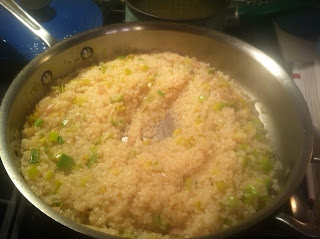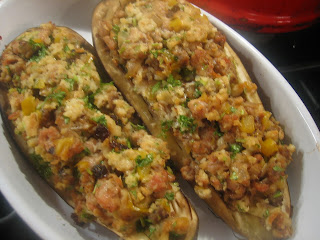A few weeks ago, I bemoaned the loss of Gourmet Magazine, which shut down in November 2009 and ended my monthly dose of Ruth Reichl. I love Reichl's writing, particularly her food writing, and it's been too long since her last book.
So when I was griping at dinner about how much I missed Gourmet, David said the fateful words "Why don't you see if there are some issues on ebay?"
I love ebay. In fact, I love ebay so much that I bought my wedding dress there three years ago and had a local costume designer take it apart and alter it. It cost a lot less than any conventional wedding dress and was way prettier.
 So as a result of David uttering those fateful words, Gourmet magazine is making a comeback at our house. It's such a joy to look at them--the photography is great, the now-dated ads are fun and the articles are so well-written. Not that I'm suggesting you go stalk these magazines on ebay, mind you. No sirree, because I have a few more I'm looking for and I don't want you to snap them up.
So as a result of David uttering those fateful words, Gourmet magazine is making a comeback at our house. It's such a joy to look at them--the photography is great, the now-dated ads are fun and the articles are so well-written. Not that I'm suggesting you go stalk these magazines on ebay, mind you. No sirree, because I have a few more I'm looking for and I don't want you to snap them up.
So how about you let me report back via a new feature that I'm calling "Vintage Gourmet"? The idea is to pull recipes from random back issues of Gourmet, put my own spin on them and post them here. Welcome to the first installment!
This recipe is a keeper: inexpensive, equally worthy of a weeknight dinner or a dinner party and less than 45 minutes to make.
Chicken with Sweet and Hot Peppers
Adapted from Gourmet Magazine, March 2003
2 lbs. bone-in, skin-on chicken thighs
2 tbsp. olive oil
2 bell peppers, preferably red and yellow, thinly sliced
1/2 onion, thinly sliced
2 cloves garlic, smashed with the flat of a knife and peeled
1/2 shallot, minced
1/4 cup dry white wine
3 dried peperoncini peppers, crushed
Kosher salt and fresh-ground black pepper
Place the chicken thighs on a paper towel-lined plate and dry thoroughly. Sprinkle salt on the skin side and put aside.
Warm the olive oil in a large, oven-safe skillet over medium heat. When the oil is shimmering, add the chicken thighs skin side down. Cook for approximately five minutes or until the chicken skin is a lovely golden brown. Then turn the chicken over with tongs and cook for an additional two minutes. The chicken will not be cooked through at this time; this is just to crisp the skin.
Pour all but about a tablespoon of the fat from the skillet and return it to the stove. Still over medium heat, add the peppers, onion and shallot and cover and cook until the veggies are softened, about ten minutes. Then add the white wine, peperoncini, garlic and salt and pepper to taste and cook until the wine has reduced, about two minutes.
Nestle the chicken skin side up in the pepper mixture, reduce heat to medium and cook, covered, for another fifteen to twenty minutes.
Start the broiler on high. Uncover the chicken and place the skillet under the broiler just until the skin is very brown and crispy.
We served with a root vegetable mash and baked leeks. Once again, remove the chicken skin if you are watching fat, cholesterol and/or calories.



















































